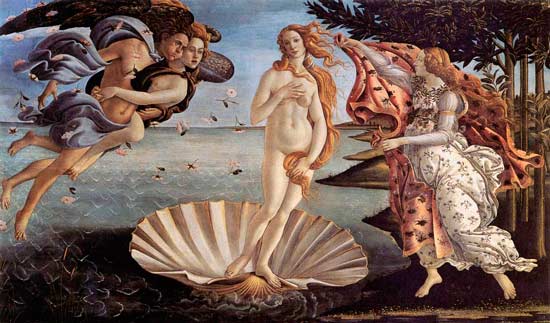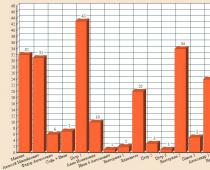Botticelli, Sandro (Filipepi, Alessandro di Mariano). Genus. 1445, Florence - d. 1510, ibid.
Sandro Botticelli is one of the most famous Florentine painters of the late 15th century. His art, designed for educated connoisseurs, imbued with motives of Neoplatonic philosophy, was not appreciated for a long time. For about three centuries, Botticelli was almost forgotten, until in the middle of the 19th century interest in his work revived, which has not faded to this day. Writers of the turn of the XIX-XX centuries. (R. Sizeran, P. Muratov) created a romantic and tragic image of the artist, which has since firmly established itself in the minds. But the documents of the late XV - early XVI centuries do not confirm such an interpretation of his personality and do not always confirm the data of the biography of Sandro Botticelli, written by Vasari.
Self-portrait of Sandro Botticelli. Detail of the painting "The Adoration of the Magi". OK. 1475
Sandro Filipepi (this is the real name of the master) was the youngest son of the tanner Mariano Filipepi, who lived in the parish of the Church of All Saints (Ognisanti). Two Botticelli brothers - Giovanni and Simone - were engaged in trade, the third - Antonio - in jewelry. The brothers' trading activities are associated with the origin of Sandro's nickname - "botticelle" ("barrel"). However, Vasari reports that this was the name of the godfather of the artist's father, Mariano, a jeweler, to whom Sandro was sent for training. There is another version, perhaps the closest to the truth, according to which the nickname passed to Sandro Botticelli from brother Antonio, and it means a distorted Florentine word " battigello"-" silversmith.
Around 1464, Sandro entered the studio of the famous artist Fra Filippo Lippi on the recommendation of his neighbor, the head of the Vespucci family. Botticelli remained there until the beginning of 1467. There is evidence that from the spring of 1467 he began to visit the workshop Andrea Verrocchio, and from 1469 he worked independently, initially at home, and then in a rented workshop. By 1470, the first work undoubtedly belonging to Botticelli, “The Allegory of Power” (Florence, Uffizi), belongs. It was part of the Seven Virtues series (the rest are Piero Pollaiolo) for the Chamber of the Merchant Court. A student of Botticelli soon became famous later Filippino Lippi, son of Fra Filippo, who died in 1469. January 20, 1474 on the occasion of the feast of St. Sebastian in the church of Santa Maria Maggiore in Florence, a painting by Sandro Botticelli "Saint Sebastian" was exhibited.
In the same year, Sandro Botticelli was invited to Pisa to work on the frescoes of Camposanto. For some unknown reason, he did not fulfill them, but in the Cathedral of Pisa he painted the fresco “Ascension of Our Lady”, which died in 1583. In the 1470s, Botticelli became close to the Medici family and the “medical circle” - Neoplatonist poets and philosophers (Marsilio Ficino, Pico della Mirandola , Angelo Poliziano). January 28, 1475 brother Lorenzo the Magnificent Giuliano took part in a tournament in one of the Florentine squares with a standard painted by Botticelli (not preserved). After the failed Pazzi conspiracy to overthrow the Medici (April 26, 1478), Botticelli, commissioned by Lorenzo the Magnificent, executed a fresco over the gates of the della Dogana, which led to the Palazzo Vecchio. It depicted the hanged conspirators (this painting was destroyed on November 14, 1494 after the flight of Piero de Medici from Florence).
Among the best works of Sandro Botticelli of the 1470s is the Adoration of the Magi, where members of the Medici family and persons close to them are shown in the images of oriental sages and their retinue. At the right edge of the picture, the artist also depicted himself.

Sandro Botticelli. Adoration of the Magi. OK. 1475. In the lower right corner of the picture, the artist depicted himself standing
Between 1475 and 1480 Sandro Botticelli created one of the most beautiful and mysterious works - the painting "Spring". It was intended for Lorenzo di Pierfrancesco Medici, with whom Botticelli had friendly relations. The plot of this picture, which combines the motives of the Middle Ages and the Renaissance, has not been fully explained so far and is obviously inspired by both Neoplatonic cosmogony and events in the Medici family.

Sandro Botticelli. Spring. OK. 1482
The early period of Botticelli's work is completed by the fresco "St. Augustine" (1480, Florence, Ognisanti Church), commissioned by the Vespucci family. She makes a couple of Domenico's compositions Ghirlandaio"St. Jerome" in the same temple. The soulful passion of the image of Augustine contrasts with the prosaism of Jerome, clearly demonstrating the differences between the deep, emotional creativity of Botticelli and the solid craft of Ghirlandaio.
In 1481, along with other painters from Florence and Umbria (Perugino, Piero di Cosimo, Domenico Ghirlandaio), Sandro Botticelli was invited to Rome by Pope Sixtus IV to work in the Sistine Chapel in the Vatican. He returned to Florence in the spring of 1482, having managed to write three large compositions in the chapel: "The Healing of a Leper and the Temptation of Christ", "The Youth of Moses" and "The Punishment of Korah, Dathan and Aviron".

Sandro Botticelli. Scenes from the life of Moses. 1481-1482

Sandro Botticelli. Punishment of Korah, Dathan and Aviron. Fresco in the Sistine Chapel. 1481-1482
In the 1480s, Botticelli continued to work for the Medici and other noble Florentine families, performing paintings on both secular and religious subjects. Around 1483 together with Filippino Lippi, Perugino and Ghirlandaio, he worked in Volterra at the villa of Spedaletto, which belonged to Lorenzo the Magnificent. The famous painting by Sandro Botticelli “The Birth of Venus” (Florence, Uffizi), made for Lorenzo di Pierfrancesco, dates back to 1487. Together with the previously created “Spring”, she became a kind of iconic image, the personification of both the art of Botticelli and the refined culture of the Medicaean court.

Sandro Botticelli. Birth of Venus. OK. 1485
The 1480s also include the two best tondos (round paintings) by Botticelli - the Madonna Magnificat and the Madonna with a Pomegranate (both - Florence, Uffizi). The latter, perhaps, was intended for the audience hall in the Palazzo Vecchio.
It is believed that since the late 1480s, Sandro Botticelli was strongly influenced by the sermons of the Dominican Girolamo Savonarola, who denounced the orders of his contemporary Church and called for repentance. Vasari writes that Botticelli was an adherent of the "sect" of Savonarola and even gave up painting and "fell into the greatest ruin." Indeed, the tragic mood and elements of mysticism in many of the master's later works testify in favor of such an opinion. At the same time, the wife of Lorenzo di Pierfrancesco, in a letter dated November 25, 1495, reports that Botticelli is painting the Medici villa in Trebbio with frescoes, and on July 2, 1497, the artist receives a loan from the same Lorenzo for the execution of decorative paintings at the Villa Castello (not preserved). In the same 1497, more than three hundred supporters of Savonarola signed a petition to Pope Alexander VI asking him to remove the excommunication from the Dominican. Among these signatures, the name of Sandro Botticelli was not found. In March 1498 Guidantonio Vespucci invited Botticelli and Piero di Cosimo to decorate their new home on Via Servi. Among the paintings that adorned him were " History of the Roman Virginia"(Bergamo, Carrara Academy) and" History of the Roman woman Lucretia"(Boston, Gardner Museum). Savonarola was burned that same year on May 29, and there is only one direct evidence of Botticelli's serious interest in his person. Almost two years later, on November 2, 1499, Sandro Botticelli's brother Simone wrote in his diary: “Alessandro di Mariano Filipepi, my brother, one of the best artists that were in these times in our city, in my presence, sitting at home by the hearth, about three o'clock in the morning, told how that day, in his boat in the house, Sandro talked with Doffo Spini about the Frate Girolamo case. Spini was the chief judge in the trial against Savonarola.

Sandro Botticelli. Lamentation of Christ (The Entombment). OK. 1490
The most significant late works by Botticelli include the two Entombments (both after 1500; Munich, Alte Pinakothek; Milan, Poldi Pezzoli Museum) and the famous Mystical Nativity (1501, London, National Gallery) - the only one signed and dated work of the artist. In them, especially in "Christmas", they see Botticelli's appeal to the methods of medieval Gothic art, primarily in violation of perspective and scale relationships.

Sandro Botticelli. Mystical Christmas. OK. 1490
However, the later works of the master are not a stylization. The use of forms and techniques that are alien to the Renaissance artistic method is explained by the desire to enhance emotional and spiritual expressiveness, for the transfer of which the specifics of the real world were not enough for the artist. One of the most sensitive painters of the Quattrocento, Botticelli extremely early felt the impending crisis of the humanistic culture of the Renaissance. In the 1520s, his offensive will be marked by the addition of the irrational and subjective art of Mannerism.
One of the most interesting aspects of Sandro Botticelli's work is portraiture. In this area, he established himself as a brilliant master already in the late 1460s (“Portrait of a Man with a Medal”, 1466-1477, Florence, Uffizi; “Portrait of Giuliano Medici”, c. 1475, Berlin, State Assemblies). In the best portraits of the master, the spirituality and refinement of the appearance of the characters are combined with a kind of hermeticism, sometimes closing them in arrogant suffering (“Portrait of a Young Man”, New York, Metropolitan Museum of Art).

Sandro Botticelli. Portrait of a young woman. After 1480
One of the most magnificent draftsmen of the 15th century, Botticelli, according to Vasari, painted a lot and "exceptionally well." Contemporaries highly valued his drawings, and in many workshops of Florentine artists they were kept as samples. So far, very few of them have survived, but the skill of Botticelli as a draftsman can be judged by a unique series of illustrations for the Divine Comedy. Dante. Executed on parchment, these drawings were intended for Lorenzo di Pierfrancesco Medici. Dante Sandro Botticelli turned to illustration twice. The first small group of drawings (not preserved) was made by him, apparently, in the late 1470s, and Baccio Baldini made nineteen engravings from it for the publication of the Divine Comedy in 1481. The most famous illustration of Botticelli to Dante is the drawing "Map of Hell" ( La mappa dell inferno).

Sandro Botticelli. Map of Hell (Circles of Hell - La mappa dell inferno). Illustration for the "Divine Comedy" by Dante. 1480s
Botticelli began to complete the sheets of the Medici code after returning from Rome, using partly his first compositions. 92 sheets have been preserved (85 in the Cabinet of Engravings in Berlin, 7 in the Vatican Library). The drawings are made with silver and lead pins, the artist then circled their thin gray line with brown or black ink. Four sheets are painted with tempera. On many sheets, the ink stroke is not finished or not done at all. It is these illustrations that especially clearly make you feel the beauty of the light, precise, nervous line of Botticelli.

Sandro Botticelli. Hell. Illustration for the "Divine Comedy" by Dante. 1480s
According to Vasari, Sandro Botticelli was "a very pleasant person and often liked to play a trick on his students and friends." “They also say,” he writes further, “that he loved above all those of whom he knew that they were diligent in their art, and that he earned a lot, but everything went to dust for him, because he was a bad manager and was careless. In the end, he became decrepit and incapacitated and walked leaning on two sticks ... "On the financial situation of Botticelli in the 1490s, that is, at the time when, according to Vasari, he had to give up painting and go bankrupt under the influence of Savonarola's sermons , partly allow judging documents from the State Archives of Florence. It follows from them that on April 19, 1494, Sandro Botticelli, together with his brother Simone, acquired a house with land and a vineyard outside the gates of San Frediano. The income from this property in 1498 was determined at 156 florins. True, since 1503 the master has been indebted for contributions to the Guild of St. Luke, but the record of October 18, 1505 reports that he has been fully repaid. The fact that the elderly Botticelli continued to be famous is also evidenced by a letter from Francesco dei Malatesti, an agent of the ruler of Mantua, Isabella d "Este, who was looking for craftsmen to decorate her studio. On September 23, 1502, he tells her from Florence that Perugino is in Siena, Filippino Lippi is too burdened with orders, but there is also Botticelli, who "praise me a lot". The trip to Mantua did not take place for an unknown reason. In 1503, Ugolino Verino in the poem "De ilrustratione urbis Florentiae" called Sandro Botticelli among the best painters, comparing him with the famous artists of antiquity - Zeuxis and Apelles. On January 25, 1504, the master was a member of the commission discussing the choice of a place to install Michelangelo's David. The last four and a half years of Sandro Botticelli's life are not documented. They were that sad time of decrepitude and inoperability that Vasari wrote about. The artist died in May 1510 and was buried on May 17 in the cemetery of the Onisanti church, as there are records of the "Book of the Dead" of Florence and the same book of the guild of doctors and pharmacists.
Other works by Botticelli: “Madonna and Child” (c. 1466, Paris, Louvre), “Madonna and Child in Glory”, “Madonna del Roseto” (both - 1469-1470, Florence, Uffizi), “Madonna and Child with St. John the Baptist" (c. 1468, Paris, Louvre), "Madonna and Child with Two Angels" (1468-1469, Naples, Capodimonte), "St. interview” (c. 1470, Florence, Uffizi), “Adoration of the Magi” (c. 1472, London, National Gallery), “Madonna of the Eucharist” (c. 1471, Boston, Gardner Museum), “Adoration of the Magi”, tondo (c. . 1473, London, National Gallery), "Discovery of the body of Holofernes", "Return of Judith to Vetilue" (both - c. 1473, Florence, Uffizi), "Portrait of Giuliano Medici" (Washington, National Gallery), "Portrait of a Young Man" (c. 1477, Paris, Louvre), Madonna and Child with Angels, Tondo (c. 1477, Berlin, State Assemblies), Lorenzo Tornabuoni and the Seven Liberal Arts, Giovanna degli Albizzi and Virtues - frescoes of the Villa Lemmi (1480, Paris, Louvre), Portrait of a Woman (1481-1482, London, private collection), Adoration of the Magi (1481-1482, Washington, National Gallery), Pallas and the Centaur (1480-1488, Florence, Uffizi), a series of four paintings based on the story of Boccaccio's story about Nastagio degli Onesti (1483, three - Madrid, Prado, one - London, private collection), "Venus and Mars" (1483, Lond he, National Gallery), "Portrait of a Boy" (1483, London, National Gallery), "Madonna and Child" (1483, Milan, Poldi Pezzoli Museum), "Madonna and Child with Two Saints" (1485, Berlin, State Assembly ), “Madonna and Child with Saints” (“Pala San Barnaba”), “Coronation of Our Lady”, “Annunciation” (all - ca. 1490, Florence, Uffizi), “Portrait of Lorenzo Lorenziano” (c. 1490, Philadelphia, Pennsylvania Academy), “Madonna and Child with St. John the Baptist" (c. 1490, Dresden, Old Masters Picture Gallery), "Adoration of the Child" (c. 1490-1495, Edinburgh, National Gallery of Scotland), "St. Augustine" (1490-1500, Florence, Uffizi), "Slander" (1495, ibid), "Madonna and Child with Angels", tondo (Milan, Pinacoteca Ambrosiana), "Annunciation" (Moscow, Pushkin Museum), "St. Jerome", "St. Dominic (St. Petersburg, State Hermitage Museum), Transfiguration (c. 1495, Rome, Pallavicini collection), Abandoned (c. 1495, Rome, Rospigliosi collection), Judith with the Head of Holofernes (c. 1495, Amsterdam, Rijksmuseum), four compositions on the history of St. Zinovia (1495-1500; two - London, National Gallery, one - New York, Metropolitan Museum of Art, one - Dresden, Art Gallery of Old Masters), "Prayer for the Cup" (c. 1499, Granada, Royal Chapel), "Symbolic Crucifixion" (1500-1505, Cambridge, Massachusetts, Fogg Art Museum).

Literature about Botticelli: Vasari 2001. Vol. 2; Dakhnovich A.S. Creativity Botticelli and eternal questions. Kiev, 1915; Burnson b. Florentine painters of the Renaissance. M., 1923; Grashchenkov V. N. Botticelli. M., 1960; Botticelli: Sat. creative materials. M., 1962; Paslo D. Botticelli. Budapest, 1962; Smirnova I. Sandro Botticelli. M., 1967; Kustodieva T. K. Sandro Botticelli. L., 1971; Dunaev G.S. Sandro Botticelli. M., 1977; Kozlova S. Dante and Renaissance Artists // Dante's Readings. M., 1982; Sonina T.V."Spring" Botticelli // Italian collection. SPb., 1996. Issue. one; Sonina T.V. Botticelli's drawings for Dante's Divine Comedy: Traditional and original // A book in the culture of the Renaissance. M., 2002; Ulmann H. Sandro Botticelli. Munich, 1893; Warburg A. Botticellis "Geburt der Venus" und Frühling": Eine Untersuchung über die Vorschtellungen von der Antike in der italienischen Frührenaissance. Hamburg; Leipzig, 1893; SupinoL I disegni per la "Divina Commedia" di Dante. Bologna, 1921; Venturi A. II Botticelli interprete di Dante. Firenze, 1921; Mesnil J. Sandro Botticelli. Paris, 1938; Lipmann F. Zeichnungen von Sandro Botticelli zu Dantes Gottlicher Komödie. Berlin, 1954; Salvini R. Tutta la pittura del Botticelli. Milano, 1958; ArgonG.C. Sandro Botticelli. Geneva, 1967; in C, Mandel G. L "opera completa del Botticelli. Milano, 1967; Ettlinger L. D., Ettlinger H. S. Botticelli. London, 1976; Lightbown R. Sandro Botticelli: Compi, cat. London, 1978; Baldini U. Botticelli. Firenze, 1988; Pons N. Botticelli Cat. compi. Milano, 1989; Botticelli e Dante. Milano, 1990; Gemeva C. Botticelli Cat. compi. Firenze, 1990; Botticelli. From Lorenzo the Magnificent to Savonarola. Milano, 2003.
Based on the article by T. Sonina
- In contact with 0
- Google Plus 0
- OK 0
- Facebook 0








